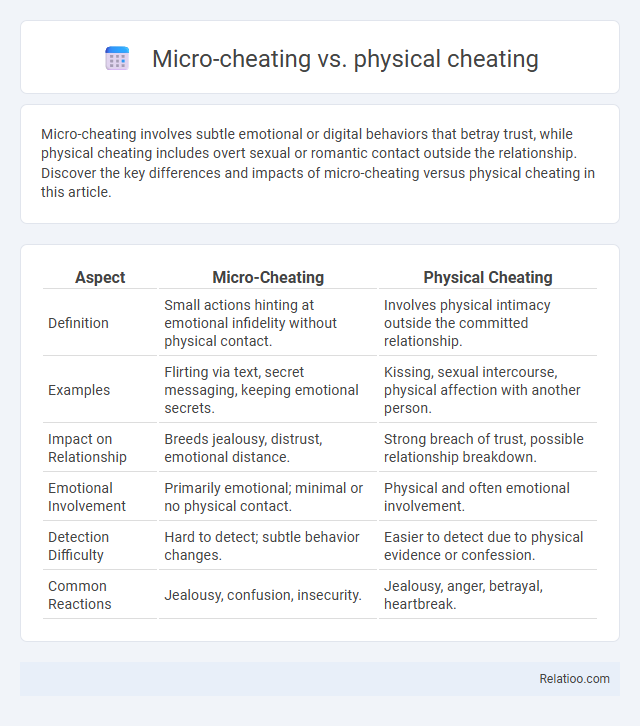Micro-cheating involves subtle emotional or digital behaviors that betray trust, while physical cheating includes overt sexual or romantic contact outside the relationship. Discover the key differences and impacts of micro-cheating versus physical cheating in this article.
Table of Comparison
| Aspect | Micro-Cheating | Physical Cheating |
|---|---|---|
| Definition | Small actions hinting at emotional infidelity without physical contact. | Involves physical intimacy outside the committed relationship. |
| Examples | Flirting via text, secret messaging, keeping emotional secrets. | Kissing, sexual intercourse, physical affection with another person. |
| Impact on Relationship | Breeds jealousy, distrust, emotional distance. | Strong breach of trust, possible relationship breakdown. |
| Emotional Involvement | Primarily emotional; minimal or no physical contact. | Physical and often emotional involvement. |
| Detection Difficulty | Hard to detect; subtle behavior changes. | Easier to detect due to physical evidence or confession. |
| Common Reactions | Jealousy, confusion, insecurity. | Jealousy, anger, betrayal, heartbreak. |
Understanding Micro-Cheating: A Modern Relationship Dilemma
Micro-cheating involves subtle behaviors like secretive texting or emotional intimacy with someone outside the relationship, blurring boundaries without physical contact. Physical cheating clearly involves sexual or romantic physical acts with another person, constituting a more overt betrayal. Understanding micro-cheating requires recognizing its emotional impact and the erosion of trust it causes, making it a significant modern relationship dilemma despite the absence of physical infidelity.
Defining Physical Cheating: What Crosses the Line?
Physical cheating involves engaging in intimate or sexual activities with someone outside your committed relationship, crossing clear boundaries of trust and fidelity. Unlike micro-cheating, which includes subtle behaviors that may hint at emotional or physical infidelity without direct contact, physical cheating definitively breaches the exclusivity expected in partnerships. Your understanding of what crosses the line should be based on mutual agreements and the impact on emotional security within your relationship.
Emotional Impact: Micro-Cheating vs Physical Cheating
Micro-cheating involves subtle behaviors like flirtatious texting or secretive social media interactions that can erode trust and cause emotional pain, often leaving your partner feeling insecure and undervalued. Physical cheating includes overt acts such as physical intimacy with someone outside the relationship, leading to profound emotional betrayal and a significant breakdown of trust. The emotional impact of micro-cheating often lingers through uncertainty and doubt, while physical cheating typically results in acute feelings of hurt and betrayal that challenge relationship stability.
Technology’s Role in Micro-Cheating
Technology plays a crucial role in micro-cheating by enabling subtle digital interactions that blur relationship boundaries, such as frequent texting, liking social media posts, or secretive online conversations. Unlike physical cheating, which involves direct physical intimacy, micro-cheating leverages technology to maintain emotional or flirtatious connections without overt physical contact. The pervasive use of smartphones and social media platforms amplifies opportunities for micro-cheating, making it difficult for partners to detect and navigate the evolving digital signs of infidelity.
Common Examples of Micro-Cheating Behaviors
Common examples of micro-cheating behaviors include frequently texting someone attractive in secret, maintaining a secret social media connection with flirtatious interactions, and hiding messages or online conversations from a partner. These subtle actions do not involve physical intimacy but often breach emotional trust, distinguishing micro-cheating from physical cheating, which involves direct physical sexual contact. Understanding these behaviors helps clarify boundaries and emotional fidelity in relationships.
Why Physical Cheating Still Matters in Relationships
Physical cheating involves direct sexual or intimate contact with someone outside the relationship, which often causes a significant breach of trust and emotional pain. Micro-cheating refers to smaller, subtle behaviors like secretive texting or flirting that may signal emotional unfaithfulness but lack physical interaction. Understanding why physical cheating still matters is crucial for your relationship's integrity, as it typically poses a clearer boundary violation and a more immediate threat to emotional and physical intimacy.
Warning Signs: Spotting Micro-Cheating Early
Warning signs of micro-cheating include secretive phone use, frequent private texting, and emotional flirtations that blur relationship boundaries without physical contact. Physical cheating involves direct intimate acts such as kissing or sexual relations outside the primary relationship, which are more overt and easier to identify than micro-cheating. Early detection of micro-cheating relies on recognizing subtle behaviors like hiding conversations, ambiguous social media interactions, and emotional intimacy with others that may indicate growing distance or deceit.
Trust Issues: How Each Type of Cheating Affects Couples
Micro-cheating often causes subtle erosion of trust through secretive behaviors like excessive flirting or emotional intimacy outside the relationship, leading partners to feel insecure and doubtful. Physical cheating severely damages trust by breaching the explicit boundaries of the relationship through intimate or sexual contact with another person, frequently resulting in profound emotional pain and a need for relationship reassessment. Micro-cheating occupies a gray area that blurs the lines of fidelity, causing ongoing suspicion and communication breakdowns that can undermine a couple's foundation more insidiously over time.
Setting Boundaries: Preventing Both Micro and Physical Cheating
Setting clear boundaries in relationships establishes mutual expectations that prevent both micro-cheating and physical cheating by defining acceptable behaviors and interactions with others. Communication about emotional needs and comfort zones reduces misunderstandings, fostering trust and accountability. Implementing agreed-upon limits on social media use, private messaging, and in-person interactions helps couples maintain loyalty and emotional fidelity.
Healing and Moving Forward After Betrayal
Healing after micro-cheating, physical cheating, or emotional betrayal requires acknowledging the specific breach of trust and its impact on your relationship. You can move forward by fostering open communication, setting clear boundaries, and seeking professional support to rebuild trust and emotional security. Prioritizing self-care and genuine forgiveness are essential steps toward recovery and reclaiming your emotional well-being.

Infographic: Micro-cheating vs Physical cheating
 relatioo.com
relatioo.com